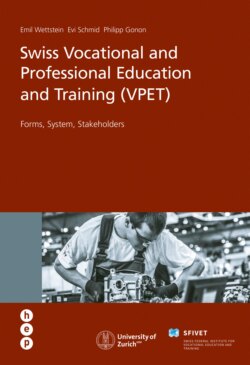Читать книгу Swiss Vocational and Professional Education and Training (VPET) - Philipp Gonon, Emil Wettstein - Страница 29
На сайте Литреса книга снята с продажи.
1.8.5 Non-formal one or two-year apprenticeship (Anlehre)
ОглавлениеThe non-formal one or two-year apprenticeship (Anlehre) was introduced by law in 1978 and was aimed at “especially practically gifted young people” (VPETA, 1978, Art. 49) who did not meet the required prerequisites for a regular apprenticeship. Instruction at vocational school was in small classes and was predominantly practice-oriented. The VET programme of the non-formal apprenticeship, which usually lasted two years, was not standardised but rather an individual training plan defined by the learner and the apprenticeship trainer. There were also no regular, standardised final examinations: the experts visited the learners for a day at the host company and checked if the apprentice had learned what had been set out in the individual VET programme (visual inspection). A supplement to the official certificate listed the skills and abilities that had been acquired.
Even if the share of learners in this informal VET programme, measured by the total share of young people in VET, had only reached a good two per cent by the end of the 1990s (Wettstein, 1999), it was an important programme for many young people. However, it did not offer the young people any regulated advancement or access to continuing education and training opportunities. In addition, the labour market success of people who completed a non-formal programme was low compared with people without any upper-secondary level qualification (Schweri, 2005).
As part of the most recent revision of the Federal Vocational and Professional Education and Training Act, the non-formal apprenticeship lost its legal basis: since 2005, such programmes have been continually replaced by two-year VET programmes with Federal VET Certificate (zweijährige berufliche Grundausbildung mit eidg. Berufsattest, EBA). In mid-2015, there were already more than 50 ordinances in force for two-year VET programmes with Federal VET Certificate, and other ordinances will follow. For professions for which there is not yet any VET programme with Federal VET Certificate, non-formal programmes could be offered until the end of 2014 at the latest. For all other professions, the last official beginning of non-formal one or two-year programmes was in 2012 (SERI, 2013j). In that year, there were still around 600 young people who began a non-formal programme (Federal Statistical Office; FSO, 2013h).
On various occasions the fear has been expressed that the two-year VET programmes with Federal VET Certificate make higher demands than the previous non-formal programmes (e.g. Aeschbach, 2006; Kammermann & Hofmann, 2008; Scherrer, 2008). This assumption is comprehensible since VET programmes with Federal VET Certificate, unlike the non-formal programmes, are oriented towards a standardised VET programme. However, this hypothesis cannot be empirically assessed until the non-formal programmes have definitively come to an end (Stern et al., 2010).
